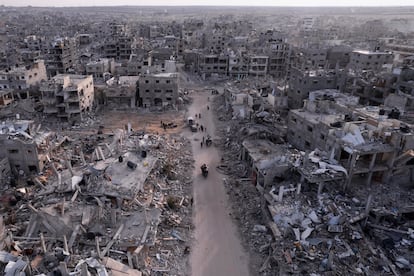
Returning to ruins in Gaza: ‘We have nothing left’
The ceasefire has enabled thousands of people to return to their places of origin, but many are met with nothing more than a mountain of rubble where their homes once stood

Mohamed al-Najjar, a 24-year-old law student, used the first day of the ceasefire on Sunday to return to his family home in Rafah, located in the southernmost part of Gaza. What he encountered, eight months after fleeing the arrival of Israeli troops, was a heap of rubble. “We have nothing left,” he said in text and video messages sent via phone. Around him, most of the neighborhood looked the same — reduced to ruins — on streets where not even the asphalt remains.
Footage reveals residents like al-Najjar wandering through the devastated border town with Egypt, assessing what remains after the intense fighting. Rafah had been the site of significant conflict: in October, Hamas leader Yahya Sinwar was killed near a tunnel where, just months earlier in July, six hostages captured during the Hamas attack on October 7, 2023 were killed before Israeli troops arrived.
“This was my home, a six-story building. Why should we return to Rafah? To cry? We can’t go back to the house that took us 30 years to build,” al-Najjar says, his frustration evident as he surveys the ruins where, until May, he lived with a dozen relatives in a building that housed about 50 residents. According to satellite image analysis by the U.N., corroborated by estimates from the University of Oregon, more than 163,000 buildings — around two-thirds of all structures in Gaza — have been destroyed.
The level of destruction in Gaza is so great that returning to their places of origin — their streets and neighborhoods — is not the same as being able to live there again, at least in the foreseeable future. For many Gazans, including Mohamed al-Najjar, the reality of the ruins leaves little choice but to move elsewhere. After visiting his demolished home in Rafah, Al Najjar almost immediately decided to return to Deir al-Balah, a town in central Gaza about six miles from Rafah, where he has been living with his family since May. “There is no habitable place in Rafah,” he concludes.
Since the war began on October 7, 2023 — triggered by a Hamas attack that killed approximately 1,200 people in Israel — around two million Gazans (out of a total population of 2.3 million) have been displaced, many multiple times, due to airstrikes and evacuation orders from the Israeli army. In a report published in November, Human Rights Watch (HRW) condemned what it described as the “massive, deliberate, forced displacement” of nearly the entire population, with “no plausible imperative military reason.”
Transport challenges further exacerbate the crisis. Limited fuel and the destruction of many vehicles have made it difficult to move around Gaza. Al Najjar recounts traveling by car to Khan Yunis before walking to Rafah. For now, he has no plans beyond waiting in Deir al-Balah, where he and his family have taken refuge.
Bodies in the rubble
Like Al Najjar, hundreds of thousands of people displaced by the 15 months of war in Gaza are using the temporary ceasefire with Israel to attempt a return to areas they fled due to bombings and military actions. NGOs, including HRW, have described these acts as “war crimes and crimes against humanity,” and even “acts of genocide.” Many return despite knowing their homes are gone, driven by the hope of locating the bodies of missing relatives beneath the rubble, according to the U.N. Relief and Works Agency for Palestine Refugees (UNRWA).
In Khan Yunis alone, emergency services report the recovery of approximately 50 bodies in recent hours. The Hamas government estimates that thousands more remain buried, adding to the over 47,000 officially recorded fatalities in Gaza as a result of Israeli attacks.
There are no precise figures on population movements, despite images showing columns of people traveling on foot, in cars, or on donkey-drawn carts. Access to some parts of the Gaza Strip, particularly the north, remains restricted. As the ceasefire progresses, occupation forces move to the rear, and Israeli authorities permit freer movement, more areas may become accessible. Residents who manage to reach their former neighborhoods often document the devastation with smartphones, capturing scenes of destruction where children, sometimes smiling and waving the Palestinian flag, appear amidst the ruins after the attacks cease.
Mustafa Ibrahim, a 62-year-old pensioner and member of the human rights organization Addameer, is preparing to return to Gaza City with his wife and three children, even though he knows his home has been destroyed. He hopes that the Israeli authorities will give the go-ahead in the next few days. “I will have to rent a house, although we don’t know where to look. Life will be difficult, and rent will be high because so few homes remain intact. Additionally, the water supply, sanitation, electricity, and internet have all been destroyed,” he explains via cell phone messages from Deir al-Balah.

On October 13, 2023, Ibrahim fled the Rimal neighborhood of Gaza City amid heavy attacks, seeking refuge in Rafah with his brothers. The family then fled again in May to Deir al-Balah, mirroring the journeys of hundreds of thousands of others. Ibrahim is nevertheless “optimistic” and “hopeful” about the ceasefire, seeing it as an opportunity to focus on reconstruction despite political divisions. Mohamed Al Najjar is also clinging on to the belief that the ceasefire is a step toward ending the conflict.
The Israeli army announced on Tuesday that, if the agreement with Hamas holds, civilians may begin returning to the north next week. This area includes Gaza City, the enclave’s main population center, and severely impacted towns like Jabalia, Beit Lahia, and Beit Hanoun. However, the Israeli military has stated that the Netzarim corridor, which effectively divides the Gaza Strip in two, will remain closed. Military spokesman Avichay Adraee also cautioned residents about the dangers of approaching the border with Israel, swimming at the beach, or fishing in the sea, emphasizing ongoing security risks.
Under the rubble of Mohamed Al Najjar’s Rafah home lies documentation he desperately needs to seek treatment abroad for his retinal condition. Having undergone surgery in Spain in 2009 as a child, he now hopes to secure a new visa for further medical care.

No comments:
Post a Comment